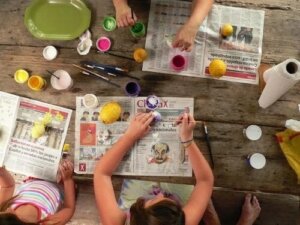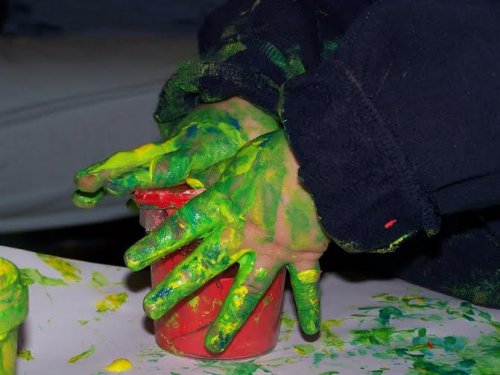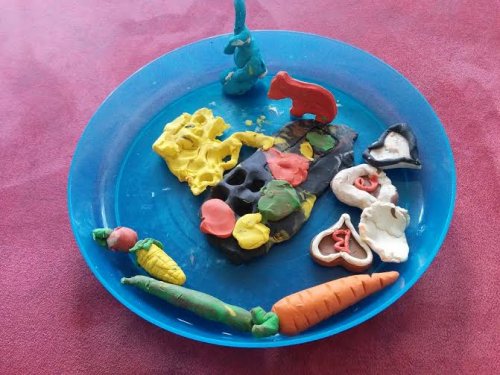What Crafts Teach Your Child


Reviewed and approved by the psychologist María Alejandra Castro Arbeláez
From the preschool stage, children learn to create by putting their artistic skills into action. On this occasion, we’ll talk about what crafts teach your child and the irreplaceable contributions to their psychomotor development.
Crafts are one of the best ways for children to learn colors, sizes, textures, geometric figures, drawing, and tearing techniques. That’s why it’s advisable, even before the child starts school, that you encourage them to do any activity of this type.
In this way, you’ll be providing opportunities to develop the mental and physical skills of your little ones. Is there any better reason than this to do crafts? However, parents often make the mistake of preventing their children from doing the manual activities assigned to them at school.
With the excuse that it’s late or that we parents can do it faster and better, we can become an obstacle for our little ones when it comes to their integral development. Faced with the risk of harming the development of our children, we want to explain what crafts teach and why your child should do arts and crafts.
Let your child develop their physical and mental skills by doing arts and crafts.
The benefits of arts and crafts

You may be interested in: Crafts for Toddlers from 1 to 3 Years Old
The following are the benefits and, in general, what arts and crafts teach your child:
Concentration
Doing any manual activity requires a certain degree of concentration, depending on the complexity of the object to be designed. In the case of children who can be scatterbrained and restless, doing crafts can help them fix their attention and energies on an object. And, without realizing it, they would be channeling their emotions in an effective way.
Coordination
When a child sets out to make crafts, they must analyze certain elements, such as what they want to design, what materials they have on hand, what the steps to follow are in order to achieve the objective, etc. It’s a small plan of action that will help them strengthen the connections between their brain, their sight, and their hands.
Creativity
Even when a child is told what the object to be made is, they’ll have the opportunity to imagine how they’ll do it. For example, if it’s a question of lining a box, the child can decide what elements they’ll use to decorate it, according to their imagination.
In the case of children over the age of five, the crafting process can be reversed. You can offer them a series of items and ask them to make whatever they want with those materials. You’ll be surprised to see what they can create.
Fine motor development
This is related to hand and finger movements, so arts and crafts are the best way to develop these types of motor skills that requires a lot of precision.
Activities that use small objects such as corn kernels, pencils, stickers, and brushes are perfect for children to perfect the technique needed to grasp these instruments.
The stimulation of memory and concentration
Performing crafts involves the use of our hands in order to manipulate materials and tools. In this regard, activities like tearing paper, holding pencils, crayons, or scissors, painting with fingers, or using brushes all require the use of the body, hands, fingers, torso, and arms.
In general, the whole body is involved in manual work with the incorporation of memory and imagination, focused on the production of an activity that helps the child communicate.
The ability to solve problems
Crafts involve the approach of a project. In this regard, they have a general objective and specific objectives, that is, the child pursues a goal and uses strategies to achieve it. These strategies come as they go along, requiring different levels of experience, intuition, and skills in the handling of resources and materials.
What we’ve said above applies to anyone who practices science or art. But also for children who make crafts, which are a playful way to solve problems.
“…cognitive development in early childhood is free and imaginative, but through its constant use, the mental understanding of the world improves more and more”.
– Educational Psychologist Lilia Angélica Campo –
The ability to work in a team
Crafts are more fun in a group. During the activity, a dialogue is generated, often silent but very meaningful, in which attention to one’s own work and that shared with others predominates.
Children stimulate each other and generate collaboration mechanisms. Each one is focused on their own task, but at the same time, they feel part of a group, of a team.
Crafts for children

To know your child is also to know what they’re capable of according to their age, that is, according to what corresponds to their cognitive development. This is decisive in order to ensure success in the handling of materials and tools (paper, scissors, glue, paintbrushes, paint pots, crayons, etc.).
Crafts for children from 2 to 3 years old
Fill in geometric shapes. Take three sheets of paper and, on each one, draw a simple geometric shape (circle, square, triangle, etc). Next, cover the drawing with a little glue stick and ask your child to fill in the shape with confetti, corn kernels, rice kernels, or any other small product they can pick up with their thumb and forefinger.
Crafts for children from 4 to 6 years old
Design a puzzle. Draw a simple landscape or cartoon character with a thick-tipped marker. With a pencil and ruler, divide the drawing into medium-sized squares (2×2 inches) and have your child cut out the squares with round-tipped scissors.
Once they’re ready, let them paint and decorate them with markers, watercolors, stickers, and glitter. When they’re done, they can put the drawing back together.
Discover: 5 Crafts to Make with Wooden Clothespins
Crafts for children from 7 to 10 years old
Origami figures. Special craft cardboard is all you’ll need to teach your child how to create 3-D figures using the folding technique. If you’re not an expert in this Asian art, don’t worry because, on the Internet, you can find plenty of videos with origami tutorials so you and your child can have fun learning together how to design animals, flowers, small boxes, and the most incredible figures.
The options for making crafts are endless. It’s only a matter of knowing what activities your child can do according to their age so that together, you can discover the most fun ways to learn.
Crafts teach you to learn
All this is a call to parents and educators not to restrict expression, the movement of the body, and thought, which are a substantial part of what crafts teach your child. Because it’s their inner being that’s being communicated through crafts.
Therefore, crafts are a pedagogical tool that favors attention, which is fundamental for teaching and learning. They provide the opportunity to create during free time when nothing’s more important than expressing oneself with shapes, colors, and materials.
If there’s a way to represent freedom, it’s through crafts.
From the preschool stage, children learn to create by putting their artistic skills into action. On this occasion, we’ll talk about what crafts teach your child and the irreplaceable contributions to their psychomotor development.
Crafts are one of the best ways for children to learn colors, sizes, textures, geometric figures, drawing, and tearing techniques. That’s why it’s advisable, even before the child starts school, that you encourage them to do any activity of this type.
In this way, you’ll be providing opportunities to develop the mental and physical skills of your little ones. Is there any better reason than this to do crafts? However, parents often make the mistake of preventing their children from doing the manual activities assigned to them at school.
With the excuse that it’s late or that we parents can do it faster and better, we can become an obstacle for our little ones when it comes to their integral development. Faced with the risk of harming the development of our children, we want to explain what crafts teach and why your child should do arts and crafts.
Let your child develop their physical and mental skills by doing arts and crafts.
The benefits of arts and crafts

You may be interested in: Crafts for Toddlers from 1 to 3 Years Old
The following are the benefits and, in general, what arts and crafts teach your child:
Concentration
Doing any manual activity requires a certain degree of concentration, depending on the complexity of the object to be designed. In the case of children who can be scatterbrained and restless, doing crafts can help them fix their attention and energies on an object. And, without realizing it, they would be channeling their emotions in an effective way.
Coordination
When a child sets out to make crafts, they must analyze certain elements, such as what they want to design, what materials they have on hand, what the steps to follow are in order to achieve the objective, etc. It’s a small plan of action that will help them strengthen the connections between their brain, their sight, and their hands.
Creativity
Even when a child is told what the object to be made is, they’ll have the opportunity to imagine how they’ll do it. For example, if it’s a question of lining a box, the child can decide what elements they’ll use to decorate it, according to their imagination.
In the case of children over the age of five, the crafting process can be reversed. You can offer them a series of items and ask them to make whatever they want with those materials. You’ll be surprised to see what they can create.
Fine motor development
This is related to hand and finger movements, so arts and crafts are the best way to develop these types of motor skills that requires a lot of precision.
Activities that use small objects such as corn kernels, pencils, stickers, and brushes are perfect for children to perfect the technique needed to grasp these instruments.
The stimulation of memory and concentration
Performing crafts involves the use of our hands in order to manipulate materials and tools. In this regard, activities like tearing paper, holding pencils, crayons, or scissors, painting with fingers, or using brushes all require the use of the body, hands, fingers, torso, and arms.
In general, the whole body is involved in manual work with the incorporation of memory and imagination, focused on the production of an activity that helps the child communicate.
The ability to solve problems
Crafts involve the approach of a project. In this regard, they have a general objective and specific objectives, that is, the child pursues a goal and uses strategies to achieve it. These strategies come as they go along, requiring different levels of experience, intuition, and skills in the handling of resources and materials.
What we’ve said above applies to anyone who practices science or art. But also for children who make crafts, which are a playful way to solve problems.
“…cognitive development in early childhood is free and imaginative, but through its constant use, the mental understanding of the world improves more and more”.
– Educational Psychologist Lilia Angélica Campo –
The ability to work in a team
Crafts are more fun in a group. During the activity, a dialogue is generated, often silent but very meaningful, in which attention to one’s own work and that shared with others predominates.
Children stimulate each other and generate collaboration mechanisms. Each one is focused on their own task, but at the same time, they feel part of a group, of a team.
Crafts for children

To know your child is also to know what they’re capable of according to their age, that is, according to what corresponds to their cognitive development. This is decisive in order to ensure success in the handling of materials and tools (paper, scissors, glue, paintbrushes, paint pots, crayons, etc.).
Crafts for children from 2 to 3 years old
Fill in geometric shapes. Take three sheets of paper and, on each one, draw a simple geometric shape (circle, square, triangle, etc). Next, cover the drawing with a little glue stick and ask your child to fill in the shape with confetti, corn kernels, rice kernels, or any other small product they can pick up with their thumb and forefinger.
Crafts for children from 4 to 6 years old
Design a puzzle. Draw a simple landscape or cartoon character with a thick-tipped marker. With a pencil and ruler, divide the drawing into medium-sized squares (2×2 inches) and have your child cut out the squares with round-tipped scissors.
Once they’re ready, let them paint and decorate them with markers, watercolors, stickers, and glitter. When they’re done, they can put the drawing back together.
Discover: 5 Crafts to Make with Wooden Clothespins
Crafts for children from 7 to 10 years old
Origami figures. Special craft cardboard is all you’ll need to teach your child how to create 3-D figures using the folding technique. If you’re not an expert in this Asian art, don’t worry because, on the Internet, you can find plenty of videos with origami tutorials so you and your child can have fun learning together how to design animals, flowers, small boxes, and the most incredible figures.
The options for making crafts are endless. It’s only a matter of knowing what activities your child can do according to their age so that together, you can discover the most fun ways to learn.
Crafts teach you to learn
All this is a call to parents and educators not to restrict expression, the movement of the body, and thought, which are a substantial part of what crafts teach your child. Because it’s their inner being that’s being communicated through crafts.
Therefore, crafts are a pedagogical tool that favors attention, which is fundamental for teaching and learning. They provide the opportunity to create during free time when nothing’s more important than expressing oneself with shapes, colors, and materials.
If there’s a way to represent freedom, it’s through crafts.
All cited sources were thoroughly reviewed by our team to ensure their quality, reliability, currency, and validity. The bibliography of this article was considered reliable and of academic or scientific accuracy.
- Álvarez Valdés, N. Música, cuerpo, movimiento y atención en niños de 4 a 5 años (Bachelor’s thesis, Universidad de La Sabana). https://intellectum.unisabana.edu.co/bitstream/handle/10818/48218/Monograf%c3%ada%20Natalia%20%c3%81lvarez%20documento%20final.pdf?sequence=1&isAllowed=y
- Benavides Arellano, G. S. (2016). Desarrollo de la creatividad en talleres prácticos de manualidades y su incidencia en el aprendizaje de los estudiantes del quinto grado, de la unidad educativa “Manuel de Jesús Calle” del cantón Quevedo, en el año 2014 (Bachelor’s thesis, Babahoyo: UTB, 2016). http://dspace.utb.edu.ec/handle/49000/2235
- Corredor Moreno, M. A. El arte como estrategia para enfocar la atención en niños de 6 años del grado primero. https://repository.unad.edu.co/handle/10596/40973
- Miranda, C. R. M. BENEFICIOS DEL JUEGO EN EL DESARROLLO INTEGRAL DE LA NIÑEZ. http://revistarayuela.ednica.org.mx/sites/default/files/Claudia%20Rebeca%20Mera%20Miranda.pdf
- Riofrio Tobar, C. E., & Mejia Coronel, M. T. (2009). Creación de talleres de artes plásticas y manualidades para niños. https://www.dspace.espol.edu.ec/handle/123456789/785
- Ternera, L. A. C. (2009). Características del desarrollo cognitivo y del lenguaje en niños de edad preescolar. Psicogente, 12(22). https://www.redalyc.org/pdf/4975/497552354007.pdf
This text is provided for informational purposes only and does not replace consultation with a professional. If in doubt, consult your specialist.








